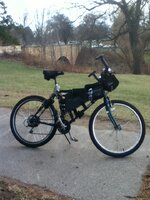Follow Up After More Than Two Years
I raised the handlebars of my Vado about two years ago (November 2019). It was the 75 mm A-HEAD stem riser I mentioned in the original post. Two years of riding and 10,200 km on my Vado 5.0 gave me a good lesson, and I want to share my recent views with you.
Raising the stem makes the riding position more upright, true. At the same time, most of your body weight will rest on the saddle. If you set off for short rides, good for you. However, riding in upright position (with almost no weight on your arms) will make your butt ache past the 40 km (25 mi) on that ride. I have ofteen been riding for longer distances, say, 80-100 km (50-62 mi) and more (my longest ride being 168 km or 104 mi). My backside was not only suffering temporarily. Frequent long distance riding made the issues accumulate in my butt (I will spare you details).
Having said the above, I need to tell you the upright riding position is not necessarily the best for long rides. That's why sporty bikes and e-bikes have their stem located at the same level as the seat, or even lower.
If you take a more forward position on your e-bike, part of your body weight will shift to your arms, relieving your butt.
My recent mods to my two current e-bikes have been:
- Vado SL: Moving the stem all way down (as much as possible). The stem got located well below the saddle
- "Big" Vado: Moving the stem down to its original position, that is, removing the stem riser. Now, the stem is inline with the saddle.
You would be surprised how these changed did me good:
- More aero position made my body act less as an air drag brake
- I stopped suffering the ass ache even on a 100 km ride
- A terrible pain in a muscle/nerves on my shoulder (near to my neck) stopped manifesting itself.
The biggest surprise to me was how easy the transition from the upright to more forward riding position was for me! I can attribute that to the extensive experience I gained on long rides. I stopped worrying so much

You could, however, say: "I feel pain in my arms and hands post-ride done in the forward position". I would agree. The grip such as Ergon GP2 or GP3, or truly ergonomic SQlab Innerbarends 411 will make miracles for you!
The bottom line: Raising the stem will make your back straight at the cost of increased air drag and pita

Riding in a more forward position will save your ass!

P.S. Sometimes, the things are not straightforward. I transferred my Trance E+ Pro 2 size M to my brother. He is far taller than I am! To compensate for that, he had to pull the seat-post up to the top allowable position. The 75 mm stem riser in his Trance moved the bars up but the stem is still located lower than the saddle! If not the stem riser, my brother would be riding with his head below his butt!
